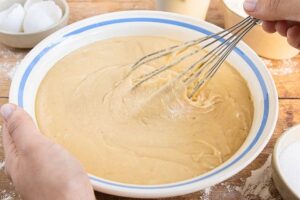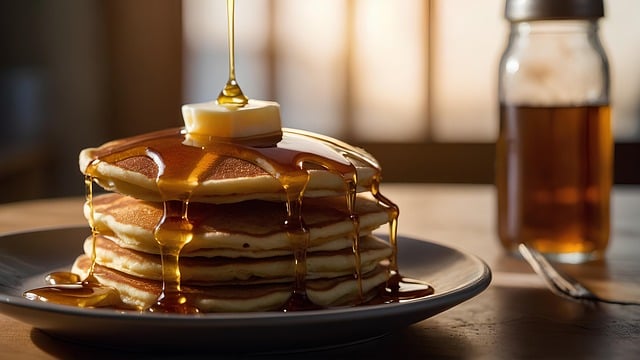Why Let Buttermilk Pancake Batter Sit?
When you prepare buttermilk pancake batter, several chemical reactions begin to take place that greatly influence the final product. Understanding these processes can help you elevate your pancakes from good to extraordinary.
The Hydration of Flour
Gluten Development and Relaxation
Flour is primarily made up of proteins, including gluten. When flour is combined with liquid ingredients like buttermilk, the gluten begins to develop. If you cook the pancakes immediately after mixing, the gluten network isn’t fully developed, resulting in tougher pancakes. By allowing the batter to rest, you give the gluten time to relax, leading to softer, fluffier pancakes.
Absorption of Moisture
The flour absorbs moisture during this rest period, which helps create a smoother batter. This not only improves the texture of the pancakes but also makes them easier to cook evenly. Pancakes made from rested batter tend to spread better on the griddle and achieve a uniform consistency.
The Role of Buttermilk in Pancake Batter
Acidic Reaction with Baking Soda
Buttermilk is a key ingredient because it is acidic. When combined with baking soda in the batter, it triggers a chemical reaction that produces carbon dioxide gas. This reaction is essential for giving the pancakes their tender and airy texture. Letting the batter rest allows this reaction to occur more fully, trapping more air bubbles within the batter. These bubbles then expand during cooking, giving you light and fluffy pancakes.
Impact on Texture and Flavor
Buttermilk not only enhances the texture of pancakes but also contributes to their unique flavor. Its slight tang and creaminess are absorbed into the flour, enhancing the overall taste. Allowing the batter to rest ensures that these flavors meld together for a more balanced and nuanced taste, making every bite of your pancakes more satisfying.
How Long Should You Let Buttermilk Pancake Batter Sit?
The amount of time you let the pancake batter sit is crucial to achieving the perfect texture and flavor.

Optimal Resting Time
15 to 30 Minutes
The ideal resting time for buttermilk pancake batter is between 15 to 30 minutes. This time frame allows the flour to hydrate fully and the gluten to relax without compromising the effectiveness of the leavening agents. If you are aiming for maximum fluffiness, some chefs recommend extending the rest to up to an hour. However, it’s important not to exceed this window as the chemical reactions between the leavening agents and the buttermilk will start to diminish, which could lead to denser pancakes.
The Minimum Time
If you’re in a rush, even a minimum of 10 minutes of rest can make a noticeable difference in the texture of your pancakes. While not as effective as the full 30 minutes, this brief rest still allows for some hydration and gluten relaxation.
Potential Drawbacks of Prolonged Resting
If the batter is left to sit for too long, especially beyond the recommended resting period, the leavening agents may lose their potency. As a result, your pancakes may not rise as much, leading to a flatter, denser texture. This is particularly important when making buttermilk pancakes since their fluffiness is one of their defining characteristics.
Does Letting Batter Sit Affect Taste?
Letting the buttermilk pancake batter sit doesn’t just affect the texture; it also enhances the flavor.
Flavor Development During Rest
Intensified Buttermilk Flavor
Buttermilk is known for its tangy, slightly creamy flavor. Allowing the batter to sit gives the buttermilk more time to infuse into the flour, intensifying the flavor. This results in pancakes with a richer, more complex taste that’s more satisfying than pancakes cooked right after mixing.
Elimination of Raw Flour Taste
Resting the batter also helps reduce the raw flour taste that can sometimes be present when the batter is cooked immediately after preparation. The slightly acidic environment created by the buttermilk neutralizes this flavor, resulting in pancakes with a more refined and pleasant taste.
How Overnight Resting Affects Flavor
If you plan to let the batter sit overnight, it’s important to adjust your approach slightly. While overnight resting can lead to even more flavorful pancakes, it requires modifications to ensure the leavening agents remain effective. Either reduce the amount of baking soda or baking powder used, or add some more in the morning just before cooking.
Can You Let Pancake Batter Sit Overnight?
Resting buttermilk pancake batter overnight can yield excellent results if done correctly. Here’s how to make it work.
Adjustments for Overnight Resting
Reduce Leavening Agents
When you prepare pancake batter the night before, the leavening agents (baking soda or powder) will start working immediately. If left for too long, their effectiveness will diminish, leading to flatter pancakes. To prevent this, reduce the amount of baking soda or powder when initially mixing the batter. Alternatively, you can wait to add the leavening agents until just before cooking the next morning.
Refrigerate and Reheat Properly
Make sure to refrigerate the batter overnight in an airtight container to prevent spoilage. When you’re ready to cook, allow the batter to come to room temperature before using it. This ensures even cooking and helps the pancakes rise properly.
Benefits of Overnight Resting
Overnight resting allows the batter even more time to develop flavor. The buttermilk continues to break down the gluten in the flour, resulting in a softer, more tender pancake. The extended resting period also allows the flavors to meld, resulting in pancakes that are richer and more flavorful than those made from freshly mixed batter.
What If You Don’t Let the Batter Rest?
Skipping the resting period won’t ruin your pancakes, but it will make a noticeable difference in the final product.
Texture and Flavor Differences
Denser, Less Fluffy Pancakes
Without resting, the gluten in the flour won’t have enough time to relax, resulting in denser pancakes. The pancakes will also likely spread less easily on the griddle and may cook unevenly, with some areas being tougher than others.
Less Developed Flavor
Resting the batter allows the flavors to meld, especially the tanginess of the buttermilk. Without this time, the flavor of the pancakes may be less pronounced and more one-dimensional.
Why You Should Let Buttermilk Pancake Batter Sit
The process of letting buttermilk pancake batter sit is rooted in improving both texture and flavor. By allowing the batter to rest, you give the flour time to hydrate, the gluten time to relax, and the leavening agents time to create the airy, tender structure that makes pancakes so delicious. The result is pancakes that are soft, fluffy, and full of flavor—an extraordinary breakfast experience.
For the best results, be sure to let your batter sit for at least 15 to 30 minutes before cooking. The small extra step will make a big difference in your final product.

